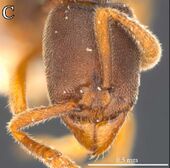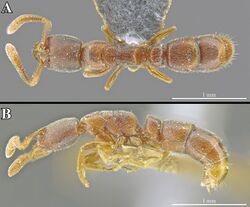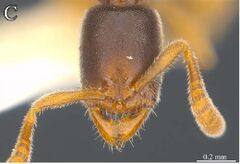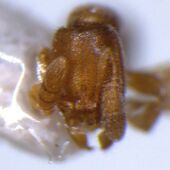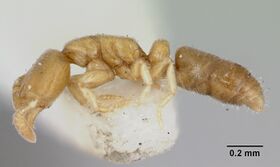Key to Ponera of East Asia
This worker key is based on: Leong, C.-M., Guenard, B., Shiao, S.-F., Lin, C.-C. 2019. Taxonomic revision of the genus Ponera Latreille, 1804 (Hymenoptera: Formicidae) of Taiwan and Japan, with a key to East Asian species. Zootaxa 4594 (1): 1–86 (DOI 10.11646/zootaxa.4594.1.1). and Pierce, M.P., Leong, C.-M., Guénard, B. 2019. A new species and new record of the cryptobiotic ant genus Ponera Latreille, 1804 (Hymenoptera, Formicidae) from Hong Kong. ZooKeys 867: 9–21 (DOI 10.3897/zookeys.867.36139)..
You may also be interested in
1
- In lateral view, petiolar node very thick with convex posterior margin; with upper portion of posterior margin bulging (Fig. 6A) . . . . . 2
- In lateral view, petiolar node not as developed and presenting straight to convex posterior margin; with upper portion of posterior margin not bulging (Fig. 6B, C) . . . . . 3
2
return to couplet #1
- Petiolar node in dorsal view with slightly convex anterior margin and slightly concave posterior margin (Fig. 7A). Smaller species, HW: 0.54–0.60 mm. Body color dark . . . . . Ponera rishen
- Petiolar node in dorsal view with strongly convex anterior margin and strongly concave posterior margin (Fig. 7B). Larger species, HW: 0.65–0.75 mm. Body color reddish brown . . . . . Ponera takaminei
3
return to couplet #1
- Eye large, each consisting of 20 or more facets (Fig. 8A). Larger species, HW: ca. 0.68 mm . . . . . Ponera kohmoku
- Eye small, each consisting of 10 or fewer facets (Fig. 8B). Size variable . . . . . 4
4
return to couplet #3
- Masticatory margin of mandible with 5 subequal large teeth (Fig. 9A). Smaller species, HW: 0.53–0.55 mm . . . . . Ponera pentodontos
- Masticatory margin of mandible with 3 or 4 enlarged teeth. (Fig. 9B). Size variable . . . . . 4a
4a
return to couplet #4
- Masticatory margin of mandible with 4 enlarged teeth followed by a small denticle . . . . . Ponera tudigong
- Masticatory margin of mandible with 3 enlarged teeth followed by a series of small to indistinct denticles; the number of denticles variable . . . . . 5
5
return to couplet #4a
- Antennal scape, when laid backward, exceeding posterior margin of head in full-face view (Fig. 10A) . . . . . 6
- Antennal scape, when laid backward, not exceeding posterior margin of head in full-face view (Fig. 10B) . . . . . 8
6
return to couplet #5
- Scape exceeding posterior border of head by nearly 34% of scape length . . . . . Ponera hubeiensis
- Scape exceeding posterior border of head by < 10% of scape length . . . . . 7
7
return to couplet #6
- Petiolar node in lateral view with straight posterior margin (Fig. 11A). HW: 0.58–0.65 mm . . . . . Ponera alisana
- Petiolar node in lateral view with convex posterior margin (Fig. 11B). HW: 0.61–0.70 mm . . . . . Ponera chapmani
8
return to couplet #5
- Petiolar node in dorsal view subrectangular or subtrapezoidal, anterior and lateral margins not forming a single arch (Fig. 12A, B: the dotted line not forming a continuously circular arc; lateral margins present), with slightly convex or almost straight anterior margin . . . . . 9
- Petiolar node in dorsal view semi-circular or oval, anterior and lateral margins constituting a single arch (Fig. 12C, D: the dotted line forming a continuously circular arc), with distinctly convex anterior margin . . . . . 12
9
return to couplet #8
- Dorsum of petiolar node in lateral view convex and relatively acute, with broadly convex posterior margin (Fig. 13A) . . . . . Ponera terayamai
- Dorsum of petiolar node in lateral view slightly convex, blunt, with straight and sloping posterior margin (Fig. 13B, C) . . . . . 10
10
return to couplet #9
- Subpetiolar process with large posteroventral teeth and large circular fenestra (Fig. 13B). Larger species, HW: 0.39–0.43 mm. Body color dark brown . . . . . Ponera chiponensis
- Subpetiolar process with small or indistinct posteroventral teeth, and small circular fenestra (Fig. 13C). Smaller species, HW: ≤ 0.35 mm. Body color yellowish brown . . . . . 11
11
return to couplet #10
- Petiolar node in dorsal view rectangular, broader than long, with slightly convex anterior margin (Fig. 14A). Larger species, HW: ca. 0.33 mm . . . . . Ponera baka
- Petiolar node in dorsal view subquadrate, about as wide as long, with straight anterior margin (Fig. 14B). Smaller species, HW: 0.27–0.28 mm . . . . . Ponera shennong
12
return to couplet #8
- Subpetiolar process without developed posteroventral teeth (Fig. 15A) . . . . . 13
- Subpetiolar process with developed posteroventral teeth (Fig. 15B) . . . . . 16
13
return to couplet #12
- Metanotal groove in lateral view indistinctly or weakly incised (Fig. 16A). Petiolar node in lateral view anterior and posterior margins converging, not parallel . . . . . 14
- Metanotal groove in lateral view deeply and broadly incised (Fig. 16B). Petiolar node in lateral view with parallel anterior and posterior margins . . . . . Ponera nangongshana
14
return to couplet #13
- In full-face view, posterior margin of head distinctly concave (Fig. 17A). Petiolar node in lateral view thick (LPeI: 63), with sloping and straight posterior margin. Smaller species, HW: ca. 0.35 mm. Body yellowish brown . . . . . Ponera xantha
- In full-face view, posterior margin of head slightly concave or straight (Fig. 17B, C). Petiolar node in lateral view relatively thin (LPeI: ca. 50), with almost vertical and slightly convex posterior margin. Larger species, HW ≥ 0.40 mm. Body brown to dark brown . . . . . 15
15
return to couplet #14
- Petiolar node in dorsal view oval, with slightly convex posterior margin (Fig. 18A). Larger species, HW: ca. 0.53 mm . . . . . Ponera bawana
- Petiolar node in dorsal view arched, with straight posterior margin (Fig. 18B). Smaller species, HW: ca. 0.40 mm . . . . . Ponera yuhuang
16
return to couplet #12
- Length of 8th antennal segment as long as 7th antennal segment (Fig. 19A) Metanotal groove indistinctly incised. Smaller species, HW: 0.30–0.31 mm . . . . . Ponera szaboi
- Length of 8th antennal segment ≥ 1.5 times length of 7th antennal segment (Fig. 19B) . . . . . 17
17
return to couplet #16
- Metanotal groove in dorsal view indistinctly incised or almost obliterated (Fig. 20A) . . . . . 18
- Metanotal groove in dorsal view weakly incised (Fig. 20B) . . . . . 22
18
return to couplet #17
- Petiolar node in dorsal view oval, with convex posterior margin (Fig. 21A). Smaller species, HW: ca. 0.45 mm . . . . . Ponera longlina
- Petiolar node in dorsal view not oval, with straight to slightly concave posterior margin (Fig. 21B, C, D). Larger species, HW ≥ 0.49 mm . . . . . 19
19
return to couplet #18
- Side of propodeum with weak to strong striae and hairs in lateral view (Fig. 22A, B, C). Body color variable. Larger species, HW ≥ 0.55 mm . . . . . 20
- Side of propodeum shining and smooth (Fig. 22D). Body color reddish brown. Smaller species, HW: 0.49–0.52 mm . . . . . Ponera wui
20
return to couplet #19
- Lateral faces of metapleuron and propodeum weakly striate (Fig. 22AC) . . . . . 21
- Lateral faces of metapleuron and propodeum strongly striate (Fig. 22B) . . . . . Ponera menglana
21
return to couplet #20
- Apex of antennal scape, when laid backward, with a remaining distance to the posterolateral corner of ca. 10% of the scape length. Lateral faces of metapleuron and propodeum weakly striate (Fig. 22C) . . . . . Ponera paedericera
- Apex of antennal scape, when laid backward, with a remaining distance to the posterolateral corner of ≤ 5% of the scape length. Metapleuron and propodeum with relatively strong striae and abundant hairs in lateral view (Fig. 22A) . . . . . Ponera scabra
22
return to couplet #17
- Anterodorsal corner of petiolar node in lateral view protruding forward (Fig. 23A) . . . . . Ponera diodonta
- Anterodorsal corner of petiolar node in lateral view not protruding forward (Fig. 23B, C, D). . . . . . 23
23
return to couplet #22
- Apex of antennal scape, when laid backward, with a remaining distance to the posterolateral corner of ≤ 5% of the scape length. . . . . . 29
- Apex of antennal scape, when laid backward, with a remaining distance to the posterolateral corner of ≥ 10% of the scape length . . . . . 24
24
return to couplet #23
- Dorsum of petiolar node in lateral view convex without forming distinct angle on posterodorsal corner; anterodorsal corner clearly much higher than posterodorsal corner (Fig. 24AB) . . . . . 25
- Dorsum of petiolar node in lateral view slightly convex without forming distinct angle on posterodorsal corner; anterodorsal corner slightly higher, or as high as posterodorsal corner (Fig. 24CDEF) . . . . . 26
25
return to couplet #24
- Third abdominal tergum distinctly longer than broad in dorsal view (ATI ≥ 105) . . . . . Ponera bishamon
- Third abdominal tergum broader than long in dorsal view (ATI ≤ 96) . . . . . Ponera pianmana
26
return to couplet #24
- Petiolar node in dorsal view relatively thicker (Fig. 25A) . . . . . 27
- Petiolar node in dorsal view relatively thin (Fig. 25B) . . . . . 28
27
return to couplet #26
- Petiolar node in dorsal view relatively thin (Fig. 24E). Posterior margin of head slightly concave (Fig. 26A). Clypeus without distinct median tooth . . . . . Ponera incerta
- Petiolar node in lateral view relatively thicker (Fig. 24F). Posterior margin of head more concave (Fig. 26B). Clypeus with distinct median tooth present (observation of the specimen using various angles needed) . . . . . Ponera taiyangshen
28
return to couplet #26
- Posterior margin of head concave (Fig. 27A). Anterior margin of petiolar node in dorsal view well convex (Fig. 25C). Larger species, HW: 0.41–0.50 mm. Body color brown . . . . . Ponera japonica
- Posterior margin of head almost straight (Fig. 27B). Anterior margin of petiolar node in dorsal view well convex (Fig. 25D). Smaller species, HW: 0.32–0.34 mm. Body color yellowish brown . . . . . Ponera swezeyi
29
return to couplet #23
- Petiolar node in lateral view with strongly convex posterior margin (Fig. 28A, B). Petiolar node in dorsal view with concave posterior margin, and large portion of the declivity clearly visible (Fig. 29A, B) . . . . . 30
- Petiolar node in lateral view with straight to slightly convex posterior margin (Fig. 28C, D). Petiolar node in dorsal view with straight or slightly concave posterior margin, and small portion of the declivity visible (Fig. 29C, D) . . . . . 31
30
return to couplet #29
- Petiolar node in lateral view with broadly convex posterior margin (Fig. 28A). Petiolar node in dorsal view thin (Fig. 29A). Body color dark brown . . . . . Ponera sinensis
- Petiolar node in lateral view with convex posterior margin (Fig. 28B). Petiolar node in dorsal view relatively thicker (Fig. 29B). Body color lighter brown . . . . . Ponera tamon
31
return to couplet #29
- Posterodorsal corner of petiolar node forming a blunt angle in lateral view (Fig. 30A specimen collected in Sarawak, Malaysia; also see Taylor 1967, Fig. 71). Subpetiolar process with small posteroventral teeth . . . . . Ponera oreas
- Posterodorsal corner of petiolar node convex in lateral view (Fig. 30B specimen collected in Vietnam; also see Zhou 2001, Fig. 74). Subpetiolar process with larger posteroventral teeth . . . . . Ponera guangxiensis



